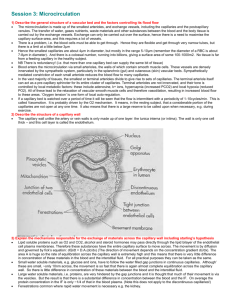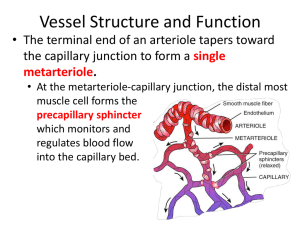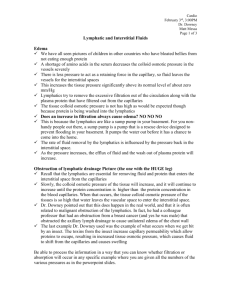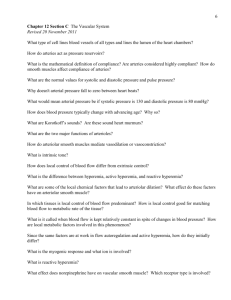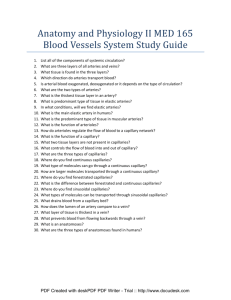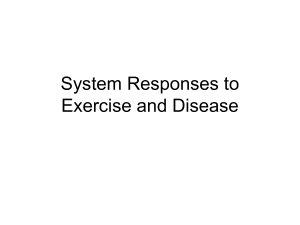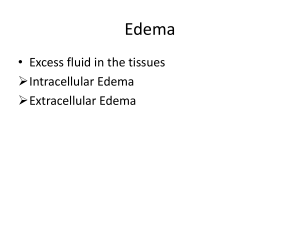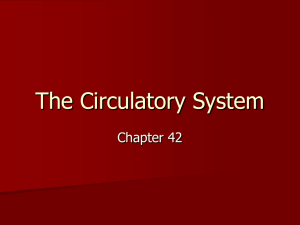13-Capillary Circulation
advertisement
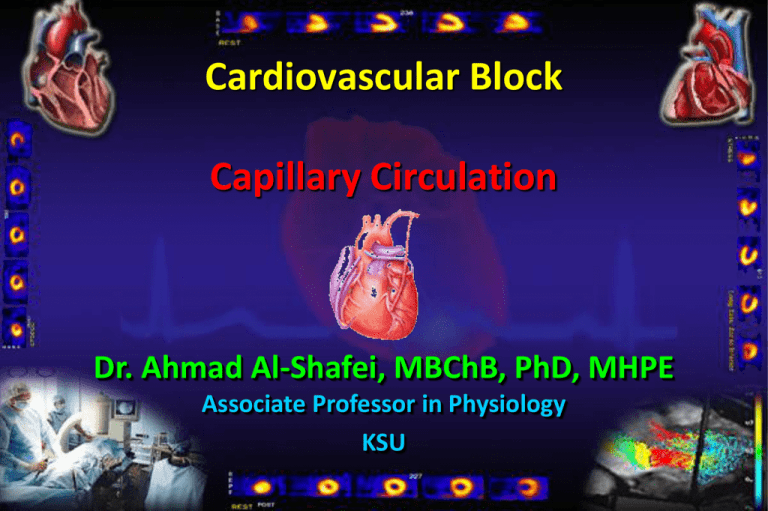
Cardiovascular Block Capillary Circulation Dr. Ahmad Al-Shafei, MBChB, PhD, MHPE Associate Professor in Physiology KSU Learning outcomes After reviewing the PowerPoint presentation, lecture notes and associated material, the student should be able to: Describe the structure of capillary wall: endothelial cells, basement membrane, intercellular clefts, vesicles, pores. Blood brain barrier to water soluble agents. Describe structure of liver and renal capillaries. Compare and contrast diffusion and filtration. State the Starling forces acting on the capillary wall: capillary blood pressure, interstitial fluid pressure, plasma protein colloid osmotic pressure, interstitial fluid colloid osmotic pressure. Describe net loss of fluid from capillaries and discuss role of lymphatics. Discuss importance of filtration giving clinical situations. Define odema, state its causes and discuss its mechanisms. Learning Resources Textbooks : Guyton and Hall, Textbook of Medical Physiology; 12th Edition. Mohrman and Heller, Cardiovascular Physiology; 7th Edition. Ganong’s Review of Medical Physiology; 24th Edition. Websites: http://accessmedicine.mhmedical.com/ The microcirculation The microcirculation refers to the microscopic divisions of the vascular system that function to bring exchange of materials between the blood and various body cells. Blood flow velocity in the capillaries? Capillaries Structure: They are small blood vessels 0.5-1mm long, 0.01mm diameter. They consist of the tunica interna only with a single layer of endothelial cells surrounded by a basement membrane. Function: Sites of exchange between blood and tissues. The arterial system delivers blood to > l billion capillaries throughout the body. Total capillary surface area=1000 m2. Capillary Beds There are 10 billion capillaries in the body. Capillaries tend to be arranged in capillary beds; only about 5% of blood volume is in the capillaries at any time. The arteriole divides into a number of metarterioles which do not have a continuous smooth muscle coat. Blood leaves the metarteriole and enters capillary bed via precapillary sphincters. Types of body capillaries Three structural types: Continuous capillaries Fenestrated capillaries Sinusoids Continuous Capillaries Continuous type of capillary found in skeletal muscle. These capillaries are present in most body tissues, e.g., muscle, lung, and adipose tissue. They have continuous endothelial lining and adjacent endothelial cells are closely joined together by tight junctions. There are thin intercellular slits (clefts) 2-10 nm in width in-between the endothelial cells that allow bulk flow of water and water soluble small ions (e.g., Na+, Cl-, and glucose). – intercellular slits (clefts) are gaps in tight junctions. – tight junctions are continuous in brain and do not allow passage of water soluble molecules. They form part of the bloodbrain barrier. Blood brain barrier Continuous Capillaries Blood Brain Barrier Fenestrated Capillaries These are found in the kidney glomeruli, small intestine, and endocrine glands. Some endothelial cells have wide intercellular pores Very permeable – allow even large substances to pass but not plasma proteins. Fenestrated type of capillary Sinusoids In these capillaries the endothelial cell are widely spaced. These have large irregular lumens slows blood flow. Located in liver, spleen, bone marrow, lymphoid tissue, some endocrine glands. Few tight junctions allow large molecules (e.g., proteins) to pass through. Mechanisms of transcapillary exchange Transport of substances across the capillary wall occurs by 3 major mechanisms: 1- Diffusion (according to concentration gradient). 2- Filtration (according to pressure gradient). 3- Vesicular transport (transcytosis). 4- Mediated (membrane) transport: This occurs in capillaries of brain only and involves secondary active transport e.g., transport of glucose; moves by cotransporters in cell membrane. Diffusion This is the process of movement of particles between the capillaries and interstitium across the capillary membrane according to their concentration (chemical) gradients. It is the major process by which most nutritional substances and waste products cross the capillary membrane. The diffusion is dependent on: - Water & lipid solubility - Molecular size of the particles - Concentration gradient Rate of diffusion for water over the whole body approximately 250 l/min. Vesicular transport (transcytosis) This is an active process by which large molecules can be transported across the capillary membrane. It includes the formation of vesicles from the endothelial membrane to surround the required particle (endocytosis). The vesicle separates and migrates across the cell to release its contents to the other side (exocytosis) e.g. Peptide hormones are moved this way Filtration Filtration is the process by which plasma and its dissolved crystalloids (electrolytes and glucose) can filter across the capillary according to pressure gradient. Filtration is determined by Starling forces. It is called bulk flow as movement of water drags along with it dissolved substance to which the membrane is permeable. Although the amount of materials exchanged by filtration are small compared to diffusion (rate of diffusion is 4000 times as the rate of filtration-reabsorption), however, filtration aids diffusion by keeping the fluid across the capillary membrane in a state of continuous motion. Transcapillary fluid dynamics Filtration forces Four pressures are involved in fluid exchange in the capillary bed: Starling forces: Capillary hydrostatic pressure tends to force fluid out. Plasma colloid osmotic pressure: sucks fluid back in. Interstitial fluid pressure. Interstitial fluid colloid osmotic pressure: sucks fluid out. Capillary blood pressure and interstitial blood pressure The capillary blood pressure (hydrostatic pressure) varies from tissue to tissue. In the renal glomeruli, it is about 60 mm Hg (filtering capillaries). In contrast, it is only about 8-10 mm Hg in those of the intestine and the pulmonary circulation absorptive capillaries). It is difficult to measure the interstitial fluid hydrostatic pressure. It is either slightly above or slightly below atmospheric pressure. (1 mm Hg above atmospheric pressure). Transcapillary fluid dynamics Arterial end of capillary Venous end of capillary Blood pressure (+40) Osmotic pressure of plasma (- 28) Osmotic pressure of interstitial fluid (+3) Blood pressure (+15) Osmotic pressure of plasma (- 28) Osmotic pressure of interstitial fluid (+3) (40 + 3) - 28 = +15 (15 + 3) - 28 = - 10 Net filtration Net absorption At arteriolar end At venular end ↓ ↓ Net reabsorption Net filtration Via lymphatics Filtration Reabsorption Normally the amount filtered slightly exceeds the amount reabsorbed and is eventually returned to the circulation via the lymphatics Filtration: (arterial end) 20ml fluid/min reabsorption: (venous end) 18ml fluid/min Hence: net filtration of about 2ml/min for entire body: removed by lymphatics (prevent oedema) Clinical significance of capillary filtration In blood loss - vasoconstriction of arterioles decrease capillary pressure hence osmotic pressure of plasma proteins favours absorption of interstitial fluid blood volume. In congestive heart failure - venous pressure rises build-up of blood in capillaries capillary pressure filtration oedema. In hypoproteinemia (e.g. starvation, liver disease) plasma protein colloid osmotic pressure loss of fluid from capillaries oedema. In inflammation: the gaps between the endothelial cells increase because of the inflammatory mediators movement of proteins into the interstitium oedema . Circulation of ECF Lymph Lymphatic vessels: lymphatic capillaries Theses are blind sacs that collect excess tissue fluid They consist of simple squamous epithelium (endothelium) Cells overlap to form valves within lumen Cells connected by filaments to structures within tissue The gaps between the endothelial cells are very large Structure of lymphatic capillaries and a collecting lymphatic, showing also the lymphatic valves Lymphatic vessels: continued Lymphatics: These originate as lymph capillaries that unite to form larger vessels - Resemble veins in structure but with thinner walls, less muscle, less connective tissue, and more valves - Connect to lymph nodes at various intervals Lymphatic trunks: These are formed by the union of lymphatics. They carry lymph to lymphatic ducts. Lymphatic ducts: these are formed by the union of lymphatic trunks. They empty into large veins just before they join the superior vena cava Lymph Circulation Lymph moves along pressure gradient about 2-4 liters/day Valves in lymph vessels keep flow moving in one direction Mechanisms that may contribute to pressure: – “milking” by skeletal muscle (contraction of skeletal muscle puts pressure on lymphatic to move fluid forward) – pressure changes during breathing (inspiration lowers pressure in thoracic cavity, increases pressure in abdominal cavity) – pulsating of neighboring elastic arteries – contraction of smooth muscle in walls of larger lymphatic vessels and ducts Lymph Protein: < plasma Lipids: cholesterol and phospholipid (lipoproteins) neutral fat (chylomicrons) Electrolytes: » similar to plasma Cells: » lymphocytes of all sizes and maturity » rare monocytes / macrophages » granulocytes following infection Edema Edema (swelling in Greek) is abnormal increase in the interstitial fluid volume. Causes: 1- Increased capillary hydrostatic pressure: - Congestive hearty failure (cardiac edema); Mechanism (Increased capillary hydrostatic pressure due to increased venous pressure) - Local arteriolar dilatation - Local venous occlusion or compression. Edema Causes: 2- Decreased capillary colloid osmotic pressure: - Decreased protein intake (starvation or nutritional edema) - Liver cirrhosis - Nephrotic syndrome 3- Increased capillary permeability: - Destruction of the endothelium (burns) - Allergic release of histamine - Infections (bacterial toxins). 4- Impaired lymphatic drainage: - Destruction of lymphatics (trauma, irradiation) - Obstruction of lymph flow (e.g., filariasis) Lymphatic Filariasis (Elephantiasis) • Parasitic Worms block the lymphatic system • Transmitted by mosquitoes
